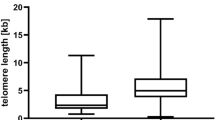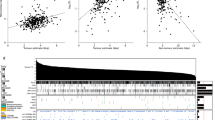Abstract
Background:
Telomere-related genes play an important role in carcinogenesis and progression of prostate cancer (PCa). It is not fully understood whether genetic variations in telomere-related genes are associated with development and progression in PCa patients.
Methods:
Six potentially functional single-nucleotide polymorphisms (SNPs) of three key telomere-related genes were evaluated in 1015 PCa cases and 1052 cancer-free controls, to test their associations with risk of PCa. Among 426 PCa patients who underwent radical prostatectomy (RP), the prognostic significance of the studied SNPs on biochemical recurrence (BCR) was also assessed using the Kaplan–Meier analysis and Cox proportional hazards regression model. The relative telomere lengths (RTLs) were measured in peripheral blood leukocytes using real-time PCR in the RP patients.
Results:
TEP1 rs1760904 AG/AA genotypes were significantly associated with a decreased risk of PCa (odds ratio (OR): 0.77, 95% confidence interval (CI): 0.64–0.93, P=0.005) compared with the GG genotype. By using median RTL as a cutoff level, RP patients with TEP1 rs1760904 AG/AA genotypes tended to have a longer RTL than those with the GG genotype (OR: 1.55, 95% CI: 1.04–2.30, P=0.031). A significant interaction between TEP1 rs1713418 and age in modifying PCa risk was observed (P=0.005). After adjustment for clinicopathologic risk factors, the presence of heterozygotes or rare homozygotes of TEP1 rs1760904 and TNKS2 rs1539042 were associated with BCR in the RP cohorts (hazard ratio: 0.53, 95% CI: 0.36–0.79, P=0.002 and hazard ratio: 1.67, 95% CI: 1.07–2.48, P=0.017, respectively).
Conclusions:
These data suggest that genetic variations in the TEP1 gene may be biomarkers for risk of PCa and BCR after RP.
This is a preview of subscription content, access via your institution
Access options
Subscribe to this journal
Receive 4 print issues and online access
$259.00 per year
only $64.75 per issue
Buy this article
- Purchase on Springer Link
- Instant access to full article PDF
Prices may be subject to local taxes which are calculated during checkout



Similar content being viewed by others
References
Center MM, Jemal A, Lortet-Tieulent J, Ward E, Ferlay J, Brawley O et al. International variation in prostate cancer incidence and mortality rates. Eur Urol 2012; 61: 1079–1092.
Cooperberg MR, Broering JM, Carroll PR . Risk assessment for prostate cancer metastasis and mortality at the time of diagnosis. J Natl Cancer Inst 2009; 101: 878–887.
Boorjian SA, Thompson RH, Tollefson MK, Rangel LJ, Bergstralh EJ, Blute ML et al. Long-term risk of clinical progression after biochemical recurrence following radical prostatectomy: the impact of time from surgery to recurrence. Eur Urol 2011; 59: 893–899.
Swanson GP, Yu C, Kattan MW, Hermans MR . Validation of post-operative nomograms in prostate cancer patients with long-term follow-up. Urology 2011; 78: 105–109.
Gallagher DJ, Vijai J, Cronin AM, Bhatia J, Vickers AJ, Gaudet MM et al. Susceptibility loci associated with prostate cancer progression and mortality. Clin Cancer Res 2010; 16: 2819–2832.
Blackburn EH, Greider CW, Szostak JW . Telomeres and telomerase: the path from maize, Tetrahymena and yeast to human cancer and aging. Nat Med 2006; 12: 1133–1138.
De Boeck G, Forsyth RG, Praet M, Hogendoorn PC . Telomere-associated proteins: cross-talk between telomere maintenance and telomere-lengthening mechanisms. J Pathol 2009; 217: 327–344.
Klapper W, Parwaresch R, Krupp G . Telomere biology in human aging and aging syndromes. Mech Ageing Dev 2001; 122: 695–712.
Meeker AK . Telomeres and telomerase in prostatic intraepithelial neoplasia and prostate cancer biology. Urol Oncol 2006; 24: 122–130.
Fordyce CA, Heaphy CM, Joste NE, Smith AY, Hunt WC, Griffith JK . Association between cancer-free survival and telomere DNA content in prostate tumors. J Urol 2005; 173: 610–614.
Treat EG, Heaphy CM, Massie LW, Bisoffi M, Smith AY, Davis MS et al. Telomere DNA content in prostate biopsies predicts early rise in prostate-specific antigen after radical prostatectomy for prostate cancer. Urology 2010; 75: 724–729.
Baydar DE, Ozen H, Geyik PO, Gurel B . Can telomere alterations predict biochemical recurrence in prostate adenocarcinoma? A preliminary study. Pathol Res Pract 2010; 206: 700–704.
Petersen G, Amundadottir L, Fuchs C, Kraft P, Stolzenberg-Solomon R, Jacobs K et al. A genome-wide association study identifies pancreatic cancer susceptibility loci on chromosomes 13q22.1, 1q32.1 and 5p15.33. Nat Genet 2010; 42: 224–228.
Bojesen SE, Pooley KA, Johnatty SE, Beesley J, Michailidou K, Tyrer JP et al. Multiple independent variants at the TERT locus are associated with telomere length and risks of breast and ovarian cancer. Nat Genet 2013; 45: 371–384.
Rafnar T, Sulem P, Stacey SN, Geller F, Gudmundsson J, Sigurdsson A et al. Sequence variants at the TERT-CLPTM1L locus associate with many cancer types. Nat Genet 2009; 41: 221–227.
Kote-Jarai Z, Olama AA, Giles GG, Severi G, Schleutker J, Weischer M et al. Seven prostate cancer susceptibility loci identified by a multi-stage genome-wide association study. Nat Genet 2011; 43: 785–791.
Kote-Jarai Z, Saunders EJ, Leongamornlert DA, Tymrakiewicz M, Dadaev T, Jugurnauth-Little S et al. Fine-mapping identifies multiple prostate cancer risk loci at 5p15, one of which associates with TERT expression. Hum Mol Genet 2013; 22: 2520–2528.
Pellatt AJ, Wolff RK, Torres-Mejia G, John EM, Herrick JS, Lundgreen A et al. Telomere length, telomere-related genes, and breast cancer risk: the breast cancer health disparities study. Genes Chromosomes Cancer 2013; 52: 595–609.
Bhattacharyya S, Keirsey J, Russell B, Kavecansky J, Lillard-Wetherell K, Tahmaseb K et al. Telomerase-associated protein 1, HSP90, and topoisomerase IIalpha associate directly with the BLM helicase in immortalized cells using ALT and modulate its helicase activity using telomeric DNA substrates. J Biol Chem 2009; 284: 14966–14977.
Hsiao SJ, Smith S . Tankyrase function at telomeres, spindle poles, and beyond. Biochimie 2008; 90: 83–92.
Mirabello L, Yu K, Kraft P, De Vivo I, Hunter DJ, Prescott J et al. The association of telomere length and genetic variation in telomere biology genes. Hum Mutat 2010; 31: 1050–1058.
Jung SW, Park NH, Shin JW, Park BR, Kim CJ, Lee JE et al. Prognostic impact of telomere maintenance gene polymorphisms in hepatocellular carcinoma patients with chronic Hepatitis B. Hepatology 2014; 59: 1912–1920.
Li Q, Gu C, Zhu Y, Wang M, Yang Y, Wang J et al. Polymorphisms in the mTOR gene and risk of sporadic prostate cancer in an Eastern Chinese population. PLoS One 2013; 8: e71968.
Wang X, Lu M, Qian J, Yang Y, Li S, Lu D et al. Rationales, design and recruitment of the Taizhou Longitudinal Study. BMC Public Health 2009; 9: 223.
Mottet N, Bellmunt J, Bolla M, Joniau S, Mason M, Matveev V et al. EAU guidelines on prostate cancer. Part II: Treatment of advanced, relapsing, and castration-resistant prostate cancer. Eur Urol 2011; 59: 572–583.
He J, Qiu LX, Wang MY, Hua RX, Zhang RX, Yu HP et al. Polymorphisms in the XPG gene and risk of gastric cancer in Chinese populations. Hum Genet 2012; 131: 1235–1244.
Cawthon RM . Telomere measurement by quantitative PCR. Nucleic Acids Res 2002; 30: e47.
Wacholder S, Chanock S, Garcia-Closas M, El Ghormli L, Rothman N . Assessing the probability that a positive report is false: an approach for molecular epidemiology studies. J Natl Cancer Inst 2004; 96: 434–442.
Chang J, Dinney CP, Huang M, Wu X, Gu J . Genetic variants in telomere-maintenance genes and bladder cancer risk. PLoS One 2012; 7: e30665.
Mirabello L, Huang WY, Wong JY, Chatterjee N, Reding D, Crawford ED et al. The association between leukocyte telomere length and cigarette smoking, dietary and physical variables, and risk of prostate cancer. Aging Cell 2009; 8: 405–413.
Shammas MA . Telomeres, lifestyle, cancer, and aging. Curr Opin Clin Nutr Metab Care 2011; 14: 28–34.
Bernardes de Jesus B, Blasco MA . Telomerase at the intersection of cancer and aging. Trends Genet 2013; 29: 513–520.
O'Sullivan J, Risques RA, Mandelson MT, Chen L, Brentnall TA, Bronner MP et al. Telomere length in the colon declines with age: a relation to colorectal cancer? Cancer Epidemiol Biomarkers Prev 2006; 15: 573–577.
Lau T, Chan E, Callow M, Waaler J, Boggs J, Blake RA et al. A novel tankyrase small-molecule inhibitor suppresses driven colorectal tumor growth. Cancer Res 2013; 73: 3132–3144.
Kang HW, Wang F, Wei Q, Zhao YF, Liu M, Li X et al. miR-20a promotes migration and invasion by regulating TNKS2 in human cervical cancer cells. FEBS Lett 2012; 586: 897–904.
Varadi V, Brendle A, Brandt A, Johansson R, Enquist K, Henriksson R et al. Polymorphisms in telomere-associated genes, breast cancer susceptibility and prognosis. Eur J Cancer 2009; 45: 3008–3016.
Prescott J, McGrath M, Lee IM, Buring JE, De Vivo I . Telomere length and genetic analyses in population-based studies of endometrial cancer risk. Cancer 2010; 116: 4275–4282.
Nan H, Qureshi AA, Prescott J, De Vivo I, Han J . Genetic variants in telomere-maintaining genes and skin cancer risk. Hum Genet 2011; 129: 247–253.
Gallagher DJ, Vijai J, Cronin AM, Bhatia J, Vickers AJ, Gaudet MM et al. Susceptibility loci associated with prostate cancer progression and mortality. Clin Cancer Res 2010; 16: 2819–2832.
Morote J, Del Amo J, Borque A, Ars E, Hernández C, Herranz F et al. Improved prediction of biochemical recurrence after radical prostatectomy by genetic polymorphisms. J Urol 2010; 184: 506–511.
Borque Á, del Amo J, Esteban LM, Ars E, Hernández C, Planas J et al. Genetic predisposition to early recurrence in clinically localized prostate cancer. BJU Int 2013; 111: 549–558.
Cheng I, Plummer SJ, Neslund-Dudas C, Klein EA, Casey G, Rybicki BA et al. Prostate cancer susceptibility variants confer increased risk of disease progression. Cancer Epidemiol Biomarkers Prev 2010; 19: 2124–2132.
Stephenson AJ, Bolla M, Briganti A, Cozzarini C, Moul JW, Roach M 3rd et al. Postoperative radiation therapy for pathologically advanced prostate cancer after radical prostatectomy. Eur Urol 2012; 61: 443–451.
Valdes AM, Andrew T, Gardner JP, Kimura M, Oelsner E, Cherkas LF et al. Obesity, cigarette smoking, and telomere length in women. Lancet 2005; 366: 662–664.
Babizhayev MA, Savel'yeva EL, Moskvina SN, Yegorov YE . Telomere length is a biomarker of cumulative oxidative stress, biologic age, and an independent predictor of survival and therapeutic treatment requirement associated with smoking behavior. Am J Ther 2011; 18: e209–e226.
Daniali L, Benetos A, Susser E, Kark JD, Labat C . Telomeres shorten at equivalent rates in somatic tissues of adults. Nat Commun 2013; 4: 1597.
Acknowledgements
This study was supported by grants from the National Natural Science Foundation of China (grant number 81272837) and Shanghai municipal hospital emerging advanced technology joint research project (grant number SHDC12013122). This study was supported by National Natural Science Foundation of China (grant number 81272837) and Shanghai municipal hospital emerging advanced technology joint research project (grant number SHDC12013122).
Author information
Authors and Affiliations
Corresponding authors
Ethics declarations
Competing interests
The authors declare no conflicts of interest.
Additional information
Supplementary Information accompanies the paper on the Prostate Cancer and Prostatic Diseases website
Supplementary information
Rights and permissions
About this article
Cite this article
Gu, C., Li, Q., Zhu, Y. et al. Genetic variants in the TEP1 gene are associated with prostate cancer risk and recurrence. Prostate Cancer Prostatic Dis 18, 310–316 (2015). https://doi.org/10.1038/pcan.2015.27
Received:
Revised:
Accepted:
Published:
Issue Date:
DOI: https://doi.org/10.1038/pcan.2015.27



